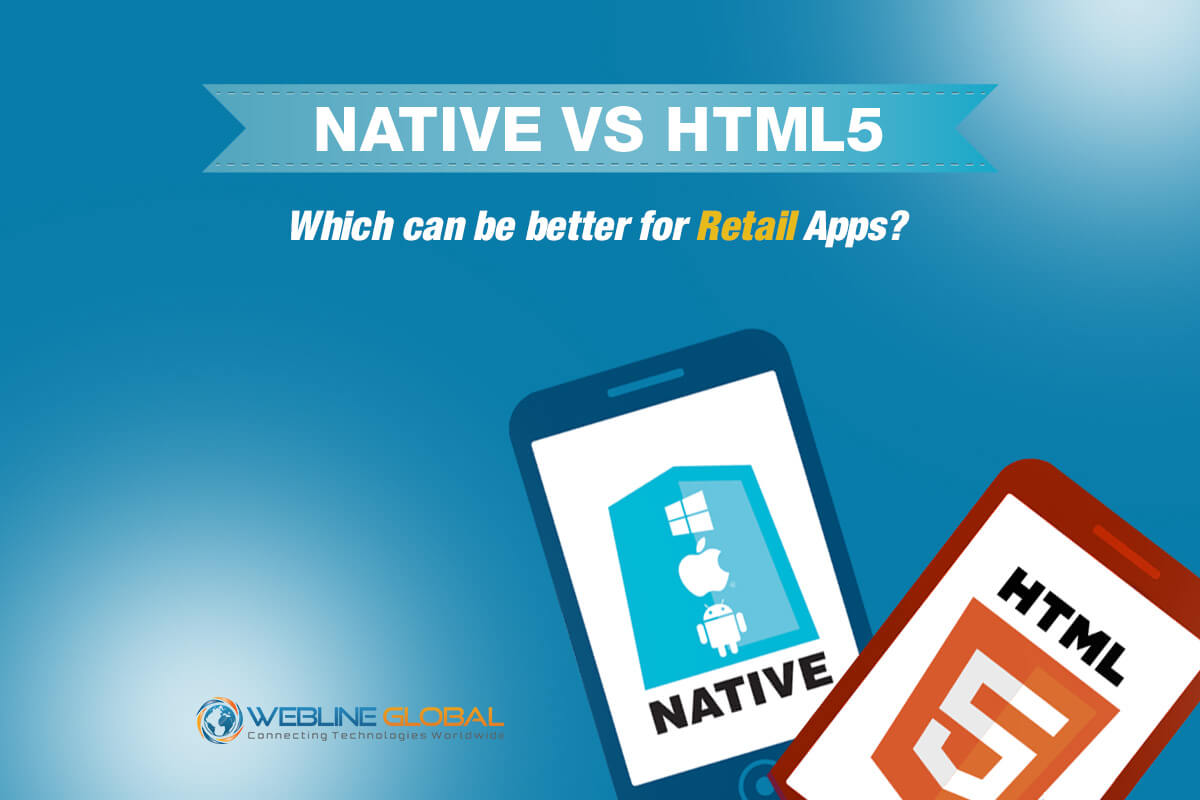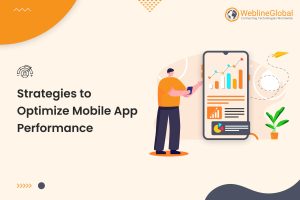
With more and more click-n-deploy platforms and millions of apps being uploaded on recognized app stores daily sustainable app lifespan is becoming a threat for many app development companies.
At the same time, app lifespan is a growing concern for large chains or enterprises in retail whose monetary growth depends a lot on their enterprise apps being used by end customers.
WeblineGlobal herewith tries to attend the “Rising Retail Concern” through following evaluators from our expertise and exposure in Native vs HTML5 app development as under
| Evaluators | Native | HTML5 |
| Engagement | They offer enhanced interaction with the users. | Development is done on a single platform, which is more cost effective with faster updates and delivery of one release to all users. |
| Flexibility | Effective promotion of the products they wish to sell better by only showing their products and filtering out the competition. | Single application for all users, regardless of operating system, hardware, or network. All iOS, Android, Windows Phone users can use the app since they need only a web browser. Write once and reuse across multiple platforms, including iOS and Android, preferring maintenance of common code base. |
| Security | Frequent access to a network is not needed, which makes them more secure. Because these apps have to gain the consent from the app store they are designed for, the user can be guaranteed of complete safety and security of the app. | Apps built with HTML5 are like any web-based applications. Developers should take proper security measures against cyber attacks to safeguard any stored data and communications. |
| Offline Storage | They can store your preferences offline and become instinctive depending on earlier purchases. | With the advent of HTML5 Application Cache, Web Storage and WebSQL we finally have a great way to make web applications work offline. Although the offline storage is limited for now. |
| Hardware use | They can utilize the Smartphone’s hardware by having more of the installed software, allowing increased functionality and direct interaction of the app with the phone without the mediation of a web browser. | Internet connection is required and they have no access to phone hardware. |
| Services | Retailers can benefit from features such as location-based services, camera and push notifications to provide an end to end captivating user experience. | Web apps can be improvised so as to be made compatible with any older mobile device. |
| Speed | They take more time to develop. | As HTML5 apps are developed using the HTML, CSS, JavaScript, and server-side languages (such as ASP.NET), it cuts down the development time. The main reasons for this are wide range of libraries for these languages (such as jQuery and JavaScript) and many trained developers. |
| App Store Visit | Unlike web apps, users need to visit app store to download apps or update the same. | Users don’t need to visit an app store to download Web apps or update the same on their mobile devices. |
| Customer Satisfaction | Having a native app fulfills customer expectations (e.g. searching for your app in the App Store). | They provide smooth mobile flow & full customer satisfaction. |
| Performance | Performance can be faster (but some mobile browsers can be faster than native apps due to optimized memory management and performance). | Mobile HTML5 apps are known to be slower than native mobile apps. Few of reasons are due to delayed updates or bugs in stock browsers on mobile platforms. |
| Marketplace | New customers / users can find you in the marketplace through the browse feature. Native apps get full support from the concerned app stores and marketplaces. Users can easily discover and download apps of their choice from these stores. | Since Web apps do not need to be approved by the app marketplace, they can be released at any time and in any form, as per the developer’s preferences. |
| For Developers | Native apps satisfy developers more, who are provided the SDK and all other tools to create the app more easily. | Web apps do not need developers to provide their app to any app store for approval. Of course, the Apple App Store does feature a list of Web apps. |
| Offline Use | Apps can be used offline. | All the apps on the platform are built in HTML5 with the addition of a few plug-ins to help enrich the user experience. With the offline application cache users can access app without network connection. |
| Distribution | They can be distributed directly through relevant app stores, which facilitate easy app installation and updates along with reducing marketing costs. | They are distributed through the rules of the open web: the link economy. |
| Monetization | As they are related to app stores, they can exploit store’s built-in monetization features like one-click payments. | HTML5 apps will tend to be monetized more through advertising. |
| Updates | They take longer time for updates compared to HTML5 as user has to download each update individually and proactively across different platforms or else the user experience can worsen over time. In fact, they would also have to be rolled out through the respective App-Stores, which means, that not every user would be using the current version of the App. | HTML5 apps support centralized updates, wherein every time the user uses the app through his/her browser, he/she views the latest version of the app, eradicating additional download requirements. |
| Developer Cost | Expensive to develop and maintain across multiple platforms (including updates and bug fixes), as developers need to build separate apps for each platform (e.g. iOS & Android, Windows and Blackberry). | As HTML5 apps are built on comparatively simpler technologies like HTML5 and JavaScript, you can easily hire affordable HTML5 developers. |
| Content | Content can’t be shared outside of the native app like it can use the web and every app distributed through app store must comply with strict content guidelines. | As HTML5 apps need to require approval from a closed app store, they can carry whatever content you need. |
| App Store fees | High app store fees may diminish your profit margins, which is really daunting, in addition to the higher development and maintenance costs of native apps. | When you release your apps directly through the browser, you can cut down the app store costs, which means you save almost 30% of your store fees. |
| Maintenance Costs | When development costs are more, it is quite obvious that maintenance costs are also on a higher scale, especially if this app supports more than one mobile platform. | They are less costly to maintain. |
| Market Reach | They don’t reach as big an audience as Web App’s can. | A robust Web App can take advantage of web traffic and can make use of SEO in a way that Native Apps cannot. By that they can have a more relevant reach at the research stage than an App-Store download. |
| User Preference | After downloading an App, fewer than 5% of users actively use it one month onwards. | During the research stage of a purchase, a user is less likely to download several bespoke Native Apps and is more likely to utilize a Smartphone’s browser and search for the product. |
| Approval | The process of getting the app approved at the app store can be long and tedious for the developer and doesn’t necessarily always result in success. Also, there is no guarantee that the app becomes instantly popular with users. | HTML5 is the best approach for mobile apps, because it prevents the need for users to update apps; it shuns the app store approval process for developers; and the apps naturally work across platforms and devices. |
| Attributes |
|
|
| Players of MADP |
| Kony, Xamarin, Adobe AIR, Sencha Touch, PhoneGap, Appcelerator, SAP, Microsoft, Blackberry, IBM, Motorola Solutions |
From above, lets’ understand how MMADP can assist in regenerating or building HTML5 apps from scratch in a short duration and sustain revenue growth.
WeblineGlobal Molecular Mobile Application Development Platform (MMADP) is a click-n-deploy scalable architecture, which can be configured through a very user friendly UI builder. Developers can auto-regenerate code from native to native, native to hybrid and vice-versa as well as native / hybrid to html5 and vice-versa. The Platform is linked to complex back-end systems / middleware / MBaaS and Compilation Servers which further synchronize UI screens to actions and generate multi-channel apps. Finally, before deployment the auto-generated App goes through our cloud hosted continuous quality assurance automation cycles where it undergoes functional and non-functional test cases across multiple OS and form factor devices mounted across multiple geographies.
Role of MMADP helpful for HTML5:
- MMADP helps CIOs and IT Directors formulating corporate application strategies. MMADP provides infrastructure needed to support HTML5 for mobile apps to make better and faster development of IT shops.
- MMADP assist to create pre-built apps that run in HTML5 modes across all the popular mobile channels.
- MMADP Platform is one of the best platforms for developers to create all types of apps for different platforms.
In current market era, HTML5 is an exciting development platform for our industry. By employing correct strategy, tools, and team, business managers and developers should be able to leverage it to provide fulfilling mobile experiences for their end users.
For a demo, click here




